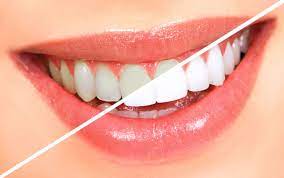Many people wonder, how does teeth whitening work? Teeth whitening is a popular cosmetic dental procedure designed to lighten the color of your teeth and remove stains or discoloration. The process involves using bleaching agents that break down stains on the enamel and sometimes the dentin, revealing a brighter, more radiant smile. Understanding how Teeth Whitening works can help you choose the right method and maintain results effectively.
The Science Behind Teeth Whitening:
Teeth whitening works primarily through chemical reactions that target the pigments causing stains. The active ingredients in whitening products penetrate the tooth surface to break down discolored molecules.
Key scientific facts include:
- The most common whitening agents are hydrogen peroxide and carbamide peroxide
- These agents release oxygen molecules that interact with pigmented compounds
- Oxidation changes the structure of stain molecules, making them less visible
- Whitening can affect both surface (extrinsic) and deeper (intrinsic) stains
- The enamel remains intact, but color lightening improves overall tooth brightness
This chemical action is what provides the noticeable whitening effect.
Types of Teeth Whitening Treatments:
There are several whitening options available, each differing in strength, application, and results.
Popular treatment types include:
- In-office whitening: Performed by dentists using high-concentration bleaching gels and sometimes light activation for quick, dramatic results
- At-home whitening kits: Custom trays with peroxide gel provided by dentists for gradual whitening over days or weeks
- Over-the-counter products: Whitening strips, gels, and toothpaste with lower peroxide levels for mild stain removal
- Natural remedies: Less effective options like baking soda or activated charcoal with limited scientific support
Choosing the right treatment depends on your preferences, budget, and desired whitening level.
What Causes Teeth Stains?
Understanding what causes teeth stains helps explain why whitening works and what results you can expect.
Common causes of discoloration include:
- Consumption of staining foods and drinks like coffee, tea, red wine, and berries
- Tobacco use leading to yellow or brown stains
- Aging, which thins enamel and exposes darker dentin underneath
- Poor dental hygiene causing plaque and tartar buildup
- Certain medications or dental trauma causing intrinsic discoloration
Whitening primarily targets extrinsic stains but can improve some intrinsic discoloration as well.
How to Prepare for Teeth Whitening?
To get the best results from teeth whitening, some preparation is necessary to ensure safety and effectiveness.
Preparation tips include:
- Visiting your dentist for a check-up and professional cleaning to remove plaque
- Addressing cavities or gum disease before whitening
- Avoiding foods and drinks that stain teeth for at least 24 hours prior
- Discussing sensitivities or allergies with your dental professional
- Following dentist instructions closely when using at-home kits
Proper preparation can reduce side effects like sensitivity and improve whitening outcomes.
Maintaining Whitening Results:
Teeth Whitening Treatment is not permanent, but proper care can extend the brightness of your smile.
Tips for maintaining whitened teeth:
- Limit consumption of staining substances such as coffee, tea, and tobacco
- Practice good oral hygiene, including regular brushing and flossing
- Use whitening toothpaste occasionally to help remove surface stains
- Avoid excessive acidic foods and drinks that erode enamel
- Schedule touch-up treatments as recommended by your dentist
Maintaining healthy habits will keep your smile shining longer after whitening treatments.
So, how does teeth whitening work? Through the use of peroxide-based bleaching agents that break down stains chemically, whitening treatments can brighten your teeth effectively. Whether done professionally or at home, understanding the process and following best practices ensures safe, lasting results and a confident smile.





Comments